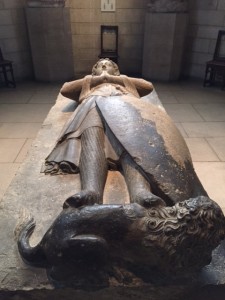The Conservation of Tomb Effigy of Jean d’Alluye
Continuing on with my visit to the Cloisters Museum in New York City, I came across a beautiful stone tomb. Strangely, half of the stone statue was black and shiny in appearance and the other half looked clean and natural. This is the Tomb Effigy of Jean d’Alluye and it is in the process of being restored. My stone restoration interest was immediately peaked!
A little background story of the tomb: it is believed to represent the noble knight Jean d’Alluye and comes from the Abbey of La Clarté-Dieu, which he helped found in 1239. After the French Revolution, the tomb was relocated and later flipped over and used as a footbridge to cross a stream.
The tomb was saved in the 19th century at the nearby castle of Hodebert and was finally purchased in 1910 from an art dealer in Paris.
So why does part of the stone look black and shiny? Apparently, the stone tomb has significantly darkened over time due to oil residues (from hands), grime and past less-effective restoration treatments. The blackish coating that I saw on the bottom part of the statue was analyzed and found to be a mix of oil, calcium sulfate and calcium carbonate. It is believed that this black sealer was added later by an art dealer in order to cosmetically hide some of the stone’s imperfections.
Traces of paint were found on the carved pillow as well, but after analysis this paint was found to be original to the artwork.
Like any good stone restoration expert would do, the stone had to be analyzed first. It is important to know what type of stone you are working with in order to properly restore it. A thin-section analysis was performed by the LRMF (Laboratoire de Recherche des Musées de France). The stone was identified as Apremont stone (also known as Noble Stone), a fine-grained, semi-hard stone surface used in antiquity, throughout the Middle Ages and Renaissance. The same stone can be found on such famous French monuments such as the Chateau Versailles.
Now to my favorite part: how is the stone of the Tomb Effigy of Jean d’Alluye being restored? Lucretia Kargère is the conservator who is working on this piece. Her work is done on-site, in the museum (rather than in a well-lit laboratory). She is removing and stripping off the build up grime and blackish coating and cleaning to restore the stone to its original golden tones. This restoration is in preparation for the 2016 exhibition, Jerusalem in the Middle Ages in the Museum’s Main Building.



